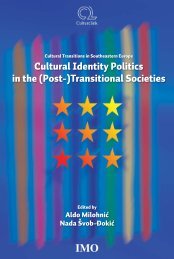D:\Documents and Settings\Ana\My Documents\Biserka-knjiga ...
D:\Documents and Settings\Ana\My Documents\Biserka-knjiga ...
D:\Documents and Settings\Ana\My Documents\Biserka-knjiga ...
You also want an ePaper? Increase the reach of your titles
YUMPU automatically turns print PDFs into web optimized ePapers that Google loves.
Digital Culture: The Changing Dynamics<br />
popularity terms, but its popularity is always brief as the turnover of content is so high<br />
because so many posts are being made all the time. Once its popularity has expired<br />
another post takes its place. The result on our logs is a short lived spike of referrals<br />
from somewhere like MySpace <strong>and</strong> it is very difficult to trace exactly what the image<br />
was, or even to find the original post unless you manage to catch the spike as it is<br />
happening.<br />
The popularity that an individual post can achieve is due partly to an increase in the<br />
quality of blogging. It has gained credibility in the mainstream as a form of media in<br />
its own right, with its own stars <strong>and</strong> professional bloggers. This leads to a higher<br />
quality <strong>and</strong> popularity of blogging overall which is helping the number of relevant<br />
referrals to sites like the 24 Hour Museum via hijacks. This in turn makes the<br />
argument for better-tagged content as, alongside search engines, it will be bloggers<br />
who will increasingly have a role to play in helping people to find relevant cultural<br />
content that is online.<br />
Like the National Museums Liverpool, the 24 Hour Museum site is well optimized<br />
in its own right, which is why our content is being found by bloggers. This<br />
optimization is grounded in the frequency of our publishing <strong>and</strong> the use of RSS feeds<br />
to get our stories out into the Web very effectively.<br />
So why have things changed in the last few years? Why are more people who<br />
hijack these images using them in context? Well, it is a result of a number of different<br />
things; the 24 Hour Museum site has become more popular <strong>and</strong> hence is better<br />
optimized (visitor numbers have risen from 83 000 in January 2003 to over one<br />
million per month in January 2007); there are a lot more people who are blogging; <strong>and</strong><br />
crucially, people are getting better at searching. It is also important to note that this is<br />
not something that is happening exclusively to the 24 Hour Museum site, the<br />
percentage of referrals from Google image search is similar on other big image rich<br />
sites like the UK’s Natural History Museum.<br />
But is all this a good thing? The view at Culture24 is definitely yes. It is an example<br />
of people appropriating an aspect of culture in personal ways that mean something to<br />
them, a sign of engagement. It is also a sign that search engines can see these images<br />
<strong>and</strong> that means people are finding them <strong>and</strong> they are then popping up on blogs <strong>and</strong><br />
social networks like Myspace. But it is still problematic for a lot of organizations as it<br />
challenges the boundaries of their institution, their curatorial control <strong>and</strong> their sense<br />
of the authority of their data. It necessitates the need to be open to the idea that<br />
knowledge comes from different places <strong>and</strong> to accept that people may want to use<br />
160



